noa* converts monumental Seventeenth-century monastery into monastero arx vivendi lodge in italy
a unique monastery-turn-hotel by noa*
noa* has transformed the monumental spaces of the 17th century monastery serve di maria addolorata into monastero arx vivendi, a unique and charming hotel in the town of arco, in alto garda, northern italy.
with the aim of restoring the spiritual dimension of the old monastic center, the south tyrol-based architects preserved most of the building’s original architectural elements, highlighting them as the main features of the hotel. ‘the majesty and rigour of the architecture, the long corridors, the vaulted ceilings, all of these features combine to give these spaces a real olde-worlde feel,’ explains noa* architect francesco padovan. in the monastery’s lush garden, a new wellness area that takes its cues from the area’s typical rural constructions offers guests 500 sqm of relaxation rooms, treatment rooms, saunas and a wellness course with steam bath.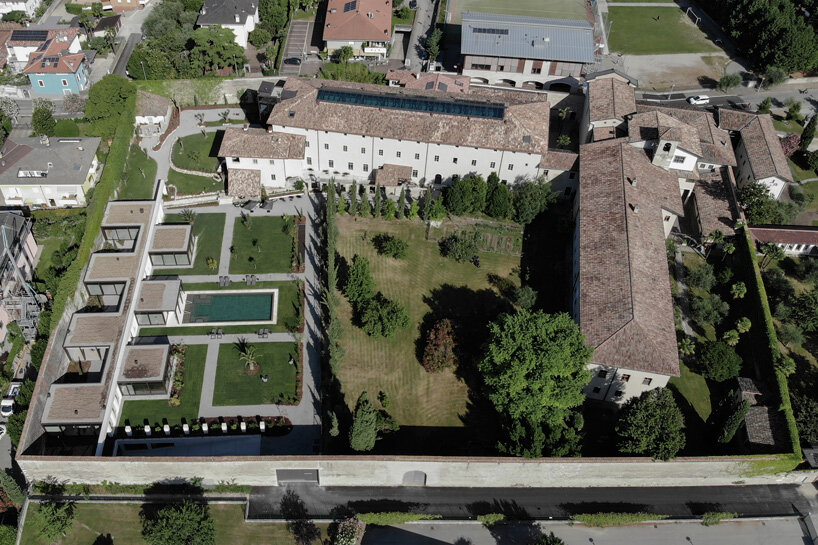 all images by alex filz, drone images by andrea dal negro
all images by alex filz, drone images by andrea dal negro
the monastero arx vivendi hotel preserves CULTURAL HERITAGE
located at the northern tip of italy’s lake garda, the monastery serve di maria addolorata consists of a building complex and an extensive garden encompassed by a high surrounding wall. half of the monastery building, which also hosts a church and cloister where nuns continue to live, has been left untouched, and in 2020 work on the monastero arx vivendi hotel began in close collaboration with the trento office of cultural heritage. the renovation by noa* consists of two main phases: the restoration and conversion of the monastery and its interiors into a hotel; and the development of a new wellness area in the garden.
with its 40 rooms and common areas, the monastero arx vivendi highlights the complex’s original architecture,
preserving the design of the internal paths and extending its geometrical rigour to the new volumes. inside, the monastery is distributed across three levels. ‘it is a bit of a surprise to discover that the spaces on every floor are structured in very different ways,’ observes francesco padovan. ‘the concentric spaces of the ground floor contrast with the majestic corridor of the first and then there is the mass of wooden beams in the loft. we paid close attention to this variety of environments, developing solutions that did not alter the various designs but which strengthened their charm and originality.’
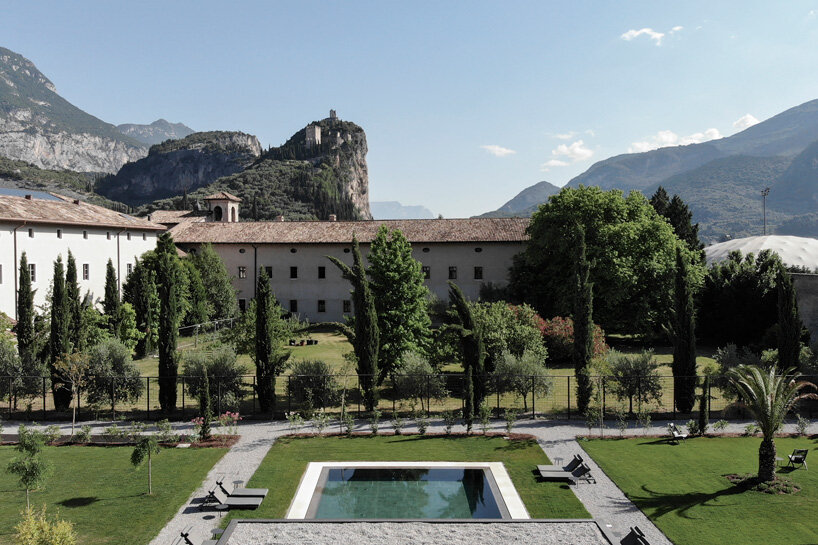
developed according to the existing plan of the monastery, the ground level houses all common spaces, including the reception, the breakfast room, the bar and kitchen, a reading room/lounge, as well as a suite with a private garden. meanwhile, on the first floor, the former monastic cells that are aligned along the sides of the 50-meter-long corridor were joined two-by-two to create larger guest rooms. in each room, one ‘cell’ encloses the bedroom, while the other hosts the bathroom. finally, the second floor features a large loft area topped by eye-catching trusses, which host two lines of rooms that also open onto a long central corridor. at the highest point of the roof, a skylight runs right along the length of the ceiling, illuminating both the corridor and the rooms thanks to the transom windows.‘the design project was guided by our complete respect for the existing architecture. the design was adapted to the austere monastic spaces with tailored solutions, without compromising on comfort, functionality and contemporary aesthetics,’ explains noa* interior designer niccolò panzani, who oversaw the interior design project.
in the monastery garden, the newly-developed spa consists of seven light glass and metal volumes positioned along a connecting spine. the spine is composed of a series of pillars covered in vicenza stone, whose colors recall the pre-existing structures, and a horizontal architrave in prefabricated and sandblasted concrete. the wellness area includes a first relaxation area with loungers, a treatment area and a second relaxation area facing the ‘biolake’ – a pool of natural water with dark blue tints. a third relaxation area is located in an open gallery in the green courtyards. finally, the saunas (a bio sauna and a finnish sauna) and a particular type of hammam or wellness course that revolves around a large heated dark stone complete the spa.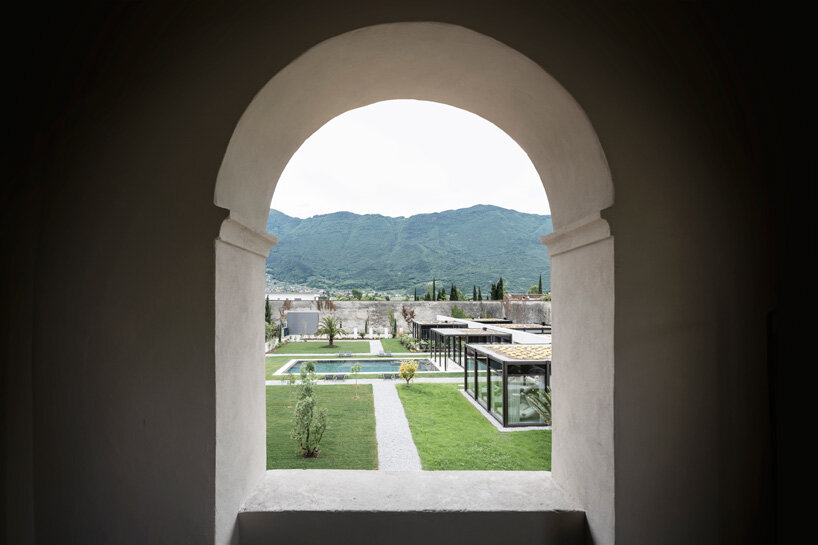
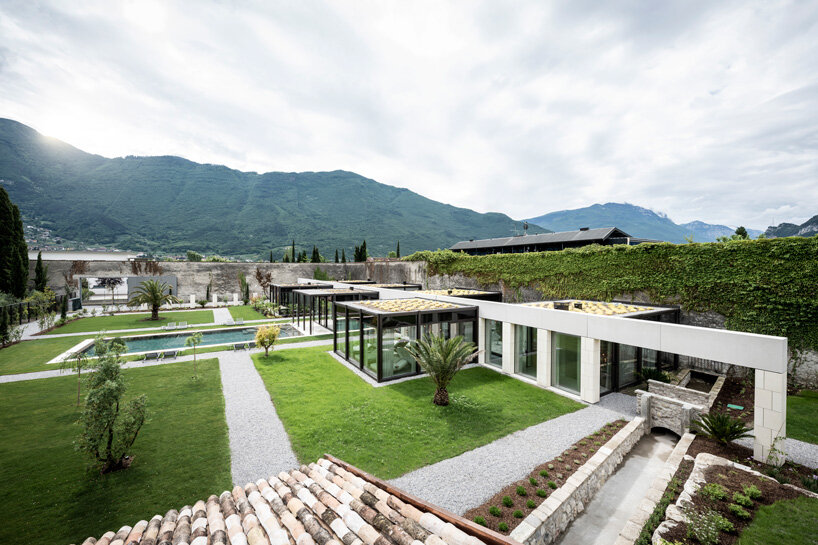
the complex is completely enclosed by a 7-meter-high boundary wall whose original appearance has been preserved
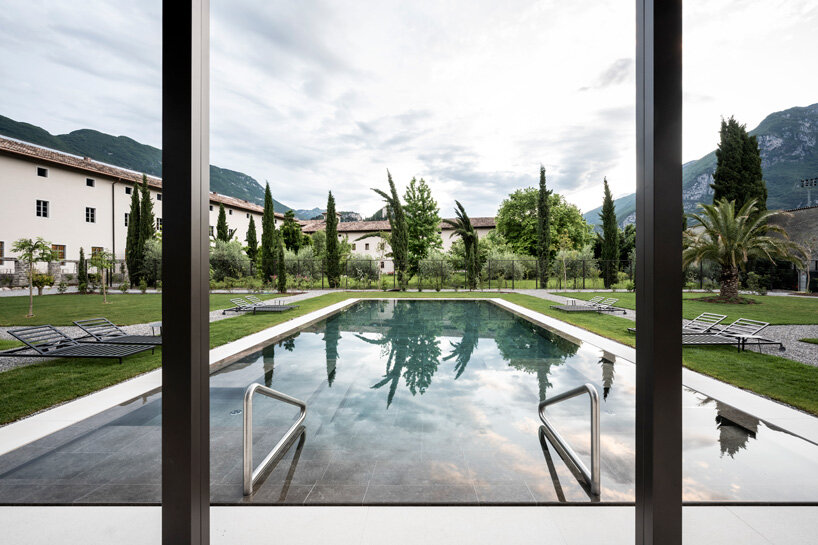
the ‘biolake’ is a pool of natural water with dark blue tints



